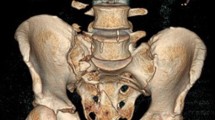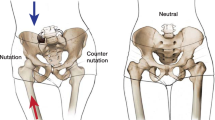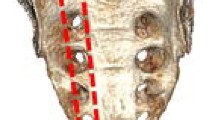Abstract
Objective
Stable internal screw fixation of posterior pelvic ring disruptions through a posterior approach.
Indications
Complete, unstable sacroiliac dislocations with incompetence of anterior and posterior sacroiliac ligaments.
Sacroiliac fracture dislocations.
Displaced vertical sacral fractures.
Contraindications
Damage to posterior soft tissues.
Acceptable closed reduction of sacrum or sacroiliac joint.
Ipsilateral acetabular fractures treated through an anterior approach.
Inadequate intraoperative fluoroscopic visualization of posterior pelvis.
Surgical Technique
Vertical paramedian incision overlying the sacroiliac joint.
Release of origin of gluteus maximus. Inspection and reduction of sacroiliac joint. Stabilization with iliosacral screws under image intensification. Secure repair of gluteal fascia.
Results
107 patients with unstable pelvic ring fractures were treated with open reduction and internal fixation of which 83 had an open reduction of posterior ring injuries. Accuracy of reduction: more than 95% of patients had residual displacement of less than 10 mm. Two patients had a deep wound infection postoperatively. Two-thirds of the patients were able to resume their previous occupation. Pain was either absent or occurred only with strenuous activities. 63% had a normal gait.
Similar content being viewed by others
References
Bucholz RW. The pathologic anatomy of Malgaigne fracture-dislocation of the pelvis. J Bone Joint Surg Am 1981;63:400–4.
Burgess AR, Eastridge BJ, Young JWR, Ellison TS, Ellison PS Jr, Poka A, Bathon GH, Brumback RJ. Pelvic ring disruptions: effective classification system and treatment protocols. J Trauma 1990;30:848–56.
Cogley D, Stephen D, Schemitsch E, McKee M. Functional outcome of pelvic fractures treated by iliosacral screw fixation. Presented at the Orthopedic Trauma Association Meeting, Vancouver, British Columbia, Canada, October 8, 1998.
Cole JD, Blum DA, Ansel LJ. Outcome after fixation of unstable posterior pelvic ring injuries. Clin Orthop 1996;329:160–79.
Denis F, Steven D, Comfort T. Sacral fractures: an important problem; retrospective analysis of 236 cases. Clin Orthop 1988;227:67–81.
Goldstein A, Phillips T, Sclafani S. Early open reduction and internal fixation of the disrupted pelvic ring. J Trauma 1986;26:325–33.
Kellam JF. The role of external fixation in pelvic disruptions. Clin Orthop 1989;241:66–82.
Kellam J, McMurty R, Paley D, Tile M. The unstable pelvic fracture: operative treatment. Orthop Clin North Am 1987;18:25–41.
Lu J, Ebraheim N, Huntoon M, Heck B, Yeasting R. Anatomic considerations of superior cluneal nerve at posterior iliac crest region. Clin Orthop 1998;347:224–8.
Matta JM. Indications for anterior fixation of pelvic fractures. Clin Orthop 1996;329:88–96.
Matta JM, Saucedo T. Internal fixation of pelvic ring fractures. Clin Orthop 1989;242:83–97.
Matta JM, Tornetta P III. Internal fixation of unstable pelvic ring injuries. Clin Orthop 1996;329:129–40.
Mears DC, Fu F. External fixation in pelvic fractures. Orthop Clin North Am 1980;11:465–79.
Moed BR, Karges DE. Techniques for reduction and fixation of pelvic ring disruptions through the posterior approach. Clin Orthop 1996;329:102–14.
Montgomery KD, Geerts WH, Potter HG, Helfet DL. Thromboembolic complications in patients with pelvic trauma. Clin Orthop 1996;329:68–87.
Mostafavi HR, Tornetta P III. Radiologic evaluation of the pelvis. Clin Orthop 1996;329:6–14.
Oliver CW, Twaddle B, Agel JL, Routt MLC. Outcome after pelvic ring fractures: evaluation using the medical outcomes short form SF-36. Injury 1996;27:635–41.
Reilly MC, Bono CM, Litkouhi B, Sirkin M, Behrens F. The effect of sacral malreduction on the safe placement of iliosacral screws. Presented at the Orthopedic Trauma Association Meeting, Charlotte, North Carolina, USA, October 22–24, 1999.
Routt MLC, Kregor PJ, Simonian PT, Mayo KA. Early results of percutaneous iliosacral screws placed with the patient in the supine position. J Orthop Trauma 1995;9:207–14.
Routt MLC, Meier MC, Kregor PJ, Mayo KA. Percutaneous iliosacral screws with the patient supine-technique. Operat Tech Orthop 1993;3:35–45.
Routt MLC, Simonian PT. Iliosacral screw complications. Presented at the Orthopedic Trauma Association Meeting, Tampa, Florida, USA, October 1, 1995.
Routt MLC, Simonian PT. Closed reduction and percutaneous skeletal fixation of sacral fractures. Clin Orthop 1996;329:121–8.
Routt MLC, Simonian PT, Agnew SG, Mann FA. Radiographic recognition of the sacral alar slope for optimal placement of iliosacral screws: a cadaveric and clinical study. J Orthop Trauma 1996;10:171–7.
Schied DK. Sacroiliac fusion at the time of fixation. Tech Orthop 1995;9:295–9.
Schopter A, Hern T, Diangelo D, Tile M. Biomechanical comparison of fixation methods of an unstable pelvic ring with sacroiliac dislocation. Orthop Trans 1994;18:17.
Semba R, Yasukawa K, Gustillo R. Critical analysis of results of 53 Malgaigne fractures of the pelvis. J Trauma 1983;23:535–7.
Simonian PT, Routt MLC. Biomechanics of pelvic fixation. Orthop Clin North Am 1997;28:351–67.
Slätis PAR, Huttinen VM. Double vertical fractures of the pelvis: a report on 163 patients. Acta Chir Scand 1972;138:799–837.
Stover MD, Sims SH, Templeman DC, Merkle P, Matta JM. Is the posterior approach to pelvic ring injuries associated with a high rate of soft tissue complications? Presented at the Orthopedic Trauma Association Meeting, Vancouver, British Columbia, Canada, October 8, 1998.
Tile M. Pelvic ring fractures: should they be fixed? J Bone Joint Surg Br 1988;70:1–12.
Tornetta P III, Matta JM. Outcome of operatively treated unstable posterior pelvic ring disruptions. Clin Orthop 1996;329:186–93.
Author information
Authors and Affiliations
Corresponding author
Rights and permissions
About this article
Cite this article
French, B., Tornetta, P. Fixation of posterior pelvic ring disruptions through a posterior approach. Orthop Traumatol 10, 27–46 (2002). https://doi.org/10.1007/s00065-002-1035-y
Issue Date:
DOI: https://doi.org/10.1007/s00065-002-1035-y




